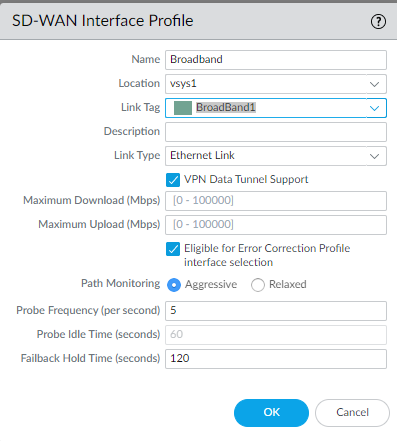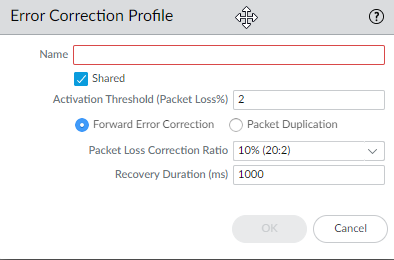SD-WAN
Recover Corrupted or Lost Data to Improve Reliability
Table of Contents
Expand All
|
Collapse All
SD-WAN Docs
-
-
-
-
- 3.4
- 3.3
- 3.2
- 3.1
- 3.0
- 2.2
- 2.1
- 2.0
- 1.0
-
Recover Corrupted or Lost Data to Improve Reliability
Create an Error Correction profile to apply Forward Error Correction (FEC) or packet
duplication for applications specified in an SD-WAN policy rule.
| Where Can I Use This? | What Do I Need? |
|---|---|
|
|
Forward error correction (FEC) is a method of correcting certain data transmission
errors that occur over noisy communication lines, thereby improving data reliability
without requiring retransmission. FEC is helpful for applications that are sensitive
to packet loss or corruption, such as audio, VoIP, and video conferencing. With FEC,
the receiving firewall can recover lost or corrupted packets by employing parity
bits that the sending encoder embeds in an application flow. Repairing the flow
avoids the need for SD-WAN data to fail over to another path or for
TCP to resend packets. FEC can also help with UDP applications by recovering the
lost or corrupt packets, since UDP does not retransmit packets.
SD-WAN FEC supports branch and hub firewalls acting as encoders and
decoders. The FEC mechanism has the encoder add redundant bits to a bitstream, and
the decoder uses that information to correct received data if necessary, before
sending it to the destination.
SD-WAN also supports packet duplication as an alternative method of
error correction. Packet duplication performs a complete duplication of an
application session from one tunnel to a second tunnel. Packet duplication requires
more resources than FEC and should be used only for critical applications that have
low tolerance for dropped packets.
Modern applications that have their own embedded recovery mechanisms may not need
FEC or packet duplication. Apply FEC or packet duplication only to applications
that can really benefit from such a mechanism; otherwise, much additional
bandwidth and CPU overhead are introduced without any benefit. Neither FEC nor
packet duplication is helpful if your SD-WAN problem is
congestion.
Neither FEC nor packet duplication should be used on DIA links; they are only for VPN
tunnel links between branches and hubs.
FEC and packet duplication is supported only for SD-WAN enabled
PAN-OS firewalls. FEC and packet duplication is not supported for Prisma Access Hubs.
To configure FEC or packet duplication on the encoder (the side that initiates FEC or
packet
duplication):
- Create an SD-WAN Interface Profile that specifies Eligible for Error Correction Profile interface selection and apply the profile to one or more interfaces.
- Create an Error Correction Profile to implement FEC or packet duplication.
- Apply the Error Correction Profile to an SD-WAN policy rule and specify a single application to which the rule applies.
- Push the configuration to encoders. (The decoder [the receiving side] requires no specific configuration for FEC or packet duplication; the mechanisms are enabled by default on the decoder as long as the encoder initiates the error correction.)
FEC and packet duplication support an MTU of 1,340 bytes. A packet larger than
that will not go through the FEC or packet duplication process.
PAN-OS & Panorama
In PAN-OS, create an Error Correction profile to apply Forward Error
Correction (FEC) or packet duplication for applications specified in an SD-WAN policy rule.
FEC and packet duplication functionality require Panorama to run PAN-OS 10.0.2 or a later release and SD-WAN plugin 2.0
or a later release that is compatible with the PAN-OS release. The
encoder and decoder must both be running PAN-OS 10.0.2 or a later
release. If one branch or hub is running an older software release than what is
required, traffic with an FEC or packet duplication header is dropped at that
firewall.
Beginning with PAN-OS 10.0.3, FEC and packet duplication are supported
in a full mesh topology, in addition to the hub-spoke topology already
supported.
- Log in to the Panorama Web Interface.Define your ISP connections and link types, where you select Eligible for Error Correction Profile interface selection to indicate that the firewall can automatically use the interfaces (where the SD-WAN Interface Profile is applied) for error correction. Whether this option defaults to selected or not depends on the Link Type you select for the profile.You can have Eligible for Error Correction Profile interface selection unchecked in a profile and apply the profile to an expensive 5G LTE link, for example, so that costly error correction is never performed on that link.
![]() Configure a physical Ethernet interface for SD-WAN and apply the SD-WAN Interface Profile that you created to an Ethernet interface.Create an Error Correction Profile for FEC or packet duplication.
Configure a physical Ethernet interface for SD-WAN and apply the SD-WAN Interface Profile that you created to an Ethernet interface.Create an Error Correction Profile for FEC or packet duplication.- Select ObjectsSD-WAN Link ManagementError Correction Profile.Add an Error Correction profile and enter a descriptive Name of up to 31 alphanumeric characters; for example, EC_VOIP.Select Shared to make the Error Correction profile available to all device groups on Panorama and to the default vsys on a single-vsys hub or branch, or to vsys1 on a multi-vsys hub or branch to which you push this configuration.Specify the Activate when packet loss exceeds (%) setting—When packet loss exceeds this percentage, FEC or packet duplication is activated for the configured applications in the SD-WAN policy rule where this Error Correction profile is applied. Range is 1 to 99; the default is 2.Select Forward Error Correction or Packet Duplication to indicate which error correction method the firewall uses when an SD-WAN policy rule references this SD-WAN Interface Profile; the default is Forward Error Correction. If you select Packet Duplication, SD-WAN selects an interface over which to send duplicate packets. (SD-WAN selects one of the interfaces you configured with Eligible for Error Correction Profile interface selection in the prior step.)(Forward Error Correction only) Select the Packet Loss Correction Ratio: 10% (20:2), 20% (20:4), 30% (20:6), 40% (20:8), or 50% (20:10)—Ratio of parity bits to data packets; the default is 10% (20:2). The higher the ratio of parity bits to data packets that the sending firewall (encoder) sends, the higher the probability that the receiving firewall (decoder) can repair packet loss. However, a higher ratio requires more redundancy and therefore more bandwidth overhead, which is a tradeoff for achieving error correction. The parity ratio applies to the encoding firewall’s outgoing traffic. For example, if the hub firewall parity ratio is 50% and the branch firewall parity ratio is 20%, the hub firewall will receive 20% and the branch firewall will receive 50%.Specify the Recovery Duration (ms)—Maximum number of milliseconds that the receiving firewall (decoder) can spend performing packet recovery on lost data packets using the parity packets it received (range is 1 to 5,000; default is 1,000). The firewall immediately sends data packets it receives to the destination. During the Recovery Duration, the decoder performs packet recovery for any lost data packets. When the recovery duration expires, all the parity packets are released. You configure the recovery duration in the Error Correction Profile for the encoder, which sends the Recovery Duration value to the decoder. A Recovery Duration setting on the decoder has no impact.Start by using the default Recovery Duration setting and adjust it if necessary, based on your testing with normal and intermittent brown-outs.
![]() Click OK.Configure an SD-WAN policy rule, reference the Error Correction Profile you created in the rule, and specify a critical application to which the rule applies.Specify only one application in the SD-WAN policy rule when configuring FEC or packet duplication. You should not combine multiple applications in a single policy rule for FEC or packet duplication.Commit and Commit and Push your configuration changes to the encoding firewalls (branches and hubs).
Click OK.Configure an SD-WAN policy rule, reference the Error Correction Profile you created in the rule, and specify a critical application to which the rule applies.Specify only one application in the SD-WAN policy rule when configuring FEC or packet duplication. You should not combine multiple applications in a single policy rule for FEC or packet duplication.Commit and Commit and Push your configuration changes to the encoding firewalls (branches and hubs).Strata Cloud Manager
In Strata Cloud Manager, create an Error Correction profile to apply Forward Error Correction (FEC) or packet duplication for applications specified in an SD-WAN policy rule.- Log in to Strata Cloud Manager.Select ManageConfigurationNGFW and Prisma Access and in the Overview, select the branch folder for which you want to create your SD-WAN Link Management profiles.To make the Error Correction profile available to all SD-WAN firewalls regardless of folder association, select All Firewalls.Create an Error Correction profile.SD-WAN supports Forward Error Correction (FEC) to correct certain data transmission errors that occur over noisy communication lines to improve data reliability without requiring retransmission or Packet Duplication to duplicate application sessions from one tunnel to another.
- Select Security ServicesSD-WAN PolicyProfilesError Correction.To make the Error Correction profile available to all SD-WAN firewalls regardless of folder association, select All Firewalls.Add Profile.Enter a descriptive Name.Specify the Activation Threshold (Packet Loss %) to set the packet loss percentage that must be exceeded before error correction is activated.Select the error correction Mode.Only a single error correction Mode can be selected for an Error Correction profile.(Forward Error Correction only) Select the Packet Loss Correction Ratio to specify the ratio of parity bits to data packets.The higher the ratio of parity bits to data packets that the sending firewall sends, the higher the probability that the receiving firewall can repair packet loss. However, a higher ratio requires more redundancy and therefore more bandwidth overhead, which is a tradeoff for achieving error correction. The parity ratio applies to the receiving firewall’s outgoing traffic.Also specify the Recovery Duration (ms) to set the maximum number of milliseconds that the receiving firewall can spend performing packet recovery on last data packets using the parity packets it received.Save.


